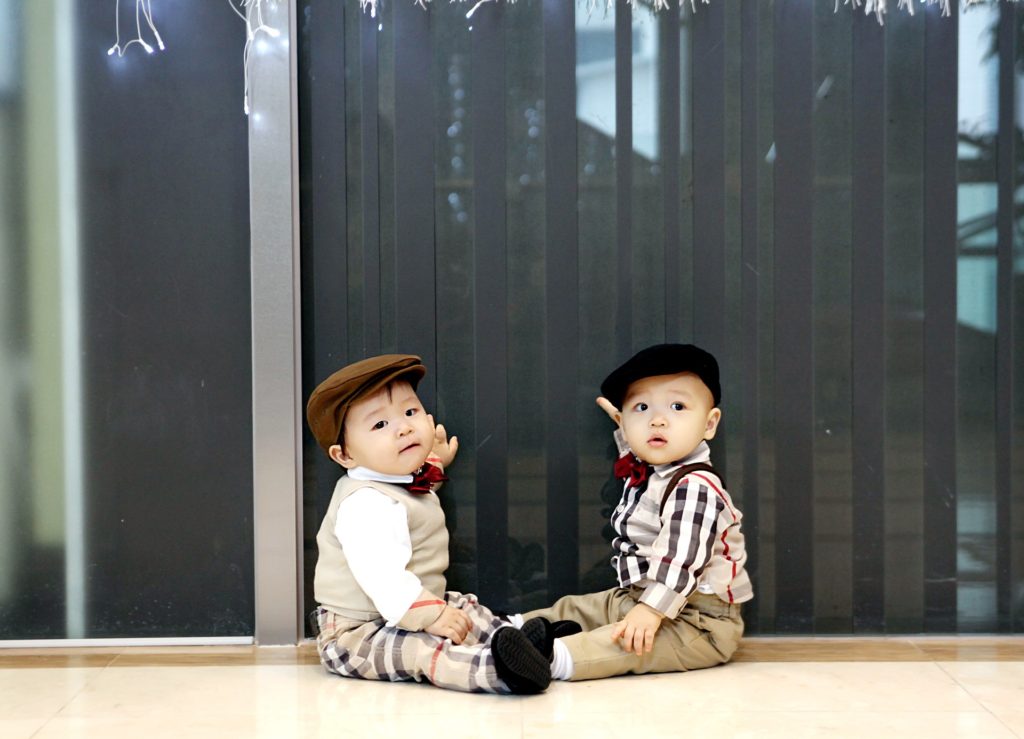Twins! After the initial shock of hearing that and nine months to mentally prepare yourself and set up a nursery for two, those precious bundles of joy are here. Double the joy? Absolutely! Double the diapers, double the feedings, and half the sleep? Sounds about right. And with double the activity, you definitely want to keep your twins on the same schedule!
For everyone’s sanity and sleep, getting and keeping your twins on the same schedule is non-negotiable. Actually pulling it off is going to require consistent effort by anyone who provides care for the babies. Check out the tips and tricks below to help you get those little ones on the right track.
How to Keep Twin Babies on the Same Schedule

Congratulations! You’ve brought you two bundles of joy home. Life with multiple babies just got real. It’s going to be crazy for a while as you all adjust to each other and work to get on some sort of schedule.
Early on, while you’re recovering from giving birth, you may choose to keep the twins near your bedside and feed them there. They may even sleep in bassinets or pack-n-plays nearby. That’s perfectly okay. Once you and the babies have settled in, you can graduate them to the nursery.
No doubt, you’ve organized the nursery with two cribs, a rocking chair, and all the necessary baby paraphernalia. Now that you’re ready to use the space, you may find you need to adjust things a little:
- Set up a place to handle feedings. You’re going to need some space to handle two babies at once. An extra-wide rocker or chair, even a designated spot on the couch, will work.
- Use a nursing pillow—a U-shaped, cloth-covered foam pillow that wraps around you. It helps your arms support and hold two babies at once.
- Swaddle the twins to give them a safe, cozy feeling.
- Keep extra pacifiers and burp cloths handy. Double the spit-up is no fun.
- Record everything! Your sleep-deprived self (we’ll work on that next) won’t remember who ate how much when. So grab a notebook or download an app and keep a record of each baby’s feeding times and amounts or duration.
Now that you’ve figured out what you need during feedings, let’s talk about how to get that schedule going.
The best place to start working towards a schedule is with feedings. Babies who eat at the same time will most likely be sleepy at the same.
Feed Your Twins at the Same Time
Whether they have a single baby or multiples, every parent works towards establishing and keeping a fairly regular feeding schedule. That’s because growing babies need a significant amount of milk each day to maintain and gain weight.
According to What to Expect, all babies need to eat frequently, especially in the beginning. For breastfed babies, that can mean 8-12 times per day or every 2-3 hours for 20-30 minutes each time. For formula-fed babies, the recommendation is 2-3 ounces every 3-4 hours at first.
With the demand for feedings and the time it takes to accomplish each one, from breast or bottle prep, buckling into the nursing pillow, burping, and the inevitable diaper change, it can feel like you’re just a milking machine. In the case of twins, feeding them at different times could literally take up the entire day and night. You do have to shower sometime, right?
On-demand feeding is typical during the first few weeks of life, as your babies learn how to nurse or adjust to a bottle. Just accept that, for a month or so, a schedule isn’t practical. But after that initial period, you can begin to get those babies on a schedule.
Feeding Tips for Twins
Here are a few tips to remember once you start to breastfeed or bottle-feed the little bundles of joy:
- Breastfeed simultaneously using the football hold. Each baby’s legs stretch out behind you, and their weight is supported by a nursing pillow or other pillows on each side of you.
- Use alternate breasts for each baby at each feeding so that if one twin is a more vigorous nurser, your breasts will not respond to that by adjusting milk supply.
- If nursing two at the same time is daunting, you can choose to nurse one while formula-feeding the other. It’s important to alternate the methods for each feeding as well.
- If you decide to bottle-feed exclusively (either formula or pumped breastmilk), try propping your twins up on Boppies to feed them at the same time. Be sure to build in some cuddle time too.
Wake the Twins Up to Eat if Necessary
The old adage of “never wake a sleeping baby” doesn’t apply when you’re trying to keep your twins on a schedule. Getting their feedings synchronized should lead to sleeping at the same time, which is definitely a worthy goal.
Sure, you may feel some guilt at having to gently nudge them awake, especially when their sleepy little eyes can’t seem to open. But it’s okay to wake them up! Honestly, even parents of single children find this to be true to keep just their one baby on some sort of consistent schedule.
Wake-Up Tips
Here are some tips to keep in mind when it comes to waking up the twins:
- Get everything ready for the feeding BEFORE you wake them up. No need to rouse those snoozers and then make them wait for the goods!
- Changing a diaper will help wake a baby up for feeding.
- If you have help, try waking the slower eater first to give that one a head start before his super-eater sibling joins the party.
Even if you need to stagger waking and feeding your twins by a few minutes (5-15 at most) to accommodate a particular baby’s needs, or for your own sanity, that’s okay. You’re still keeping their feeding times relatively close to each other in the overall scheme of things.
Synchronize the Twins’ Sleep

Hopefully, getting your twins’ eating schedule established will lead to them sleeping at the same time. And that means sleep for everyone else in the house too! Consistency is key to helping your babies recognize and accept the schedule you’re trying to follow.
We’re all different with different habits, preferences, and needs. It’s the same with twins. One may need more sleep; the other could take longer to sleep or wants more soothing to settle down.
With a little time, patience (often in short supply, we know), and consistency, you can sleep train your two babies to sleep at basically the same time and soothe themselves back to sleep if they wake up during the night or nap.
Note: By definition, sleep training is teaching your baby to fall asleep with no help. She goes down awake and doesn’t need nursing, cuddling, rocking, or other contact with you to fall asleep.
When to Start Sleep Training
Newborns sleep a lot. Our best advice for those first couple of months is to sleep when the twins sleep. During the two to four or five-month phase, your babies should begin to settle into a sleep-eat rhythm. Most babies start to wake up and fall asleep around the same time during the day and night.
Once your babies reach about four months, you can start working on a consistent sleep schedule that puts them both on the train to Sleepy Town together and gives them the ability to self-soothe if they do wake up during nap or at night.
How to Sleep Train a Baby
What to Expect defines five methods for sleep training your baby—or babies—to soothe themselves back to sleep. You may find that it takes a combination approach since you’re working with two distinct personalities:
- Cry It Out (CIO): Baby cries until she falls asleep. It’s harder on you than the twins and may require them to be in separate rooms.
- Check and Console: Let the baby cry for a set amount of time before going in to check and soothe.
- The Chair: Sit in a chair beside the crib while the babies fall asleep. Gradually move the chair until you’re sitting by the door.
- Bedtime Fade: If one twin isn’t ready for sleep when the time comes, go ahead and put them both down. After a few minutes, let the one who won’t go to sleep get up for a limited time before trying again. In a few nights, move bedtime back about 15 minutes and try that. Keep adjusting the time until it coincides with the other twin’s bedtime.
- Pick Up, Put Down: Go through the usual bedtime routine and lay the babies down, sleepy but awake. If one cries, wait a few minutes before going in. Pick the crying baby up and soothe her, then lay her back down.
Obviously, the trick is to train each of them without waking the other one up. And we’ll address that in the next section.
Sleep Train in the Same Room or Not?
Your twins spent nine months together in the womb, and they will continue to count on each other for comfort and connection after birth. Chances are you’ve got both cribs set up in the nursery. The babies may even prefer sleeping in the same crib for a while.
It’s when you’re trying to get your twins to sleep at the same time that being in the same room can cause problems. If they’re both sound sleepers and don’t wake each other up, great! Training them to self-soothe is a lot easier.
However, sometimes one twin cries louder or more often than the other twin and wakes his snoozing partner up. Going in to check on the crying baby can wake up the still-sleeping one too. Each of the five methods discussed above involves crying for various lengths of time, so consider separating your twins temporarily.
Leave the fussier baby in the nursery and move the sound sleeper to a pack-n-play in a spare room if your home has the available space. Setting a pack-n-play up in your bedroom means you’ll have to get up to visit the nursery when the fussy one cries, but hopefully, your snoozer will sleep through it all in the quiet of the separate room.
Recognize their Signs of Sleep
Take advantage of your babies’ natural sleep rhythms by recognizing signs that one or both are sleepy. Once one of them starts sending out one of these sleep signals, begin your “time for bed” routine with both:
- Yawning
- Looking drowsy
- Nodding off
- Rubbing the eyes
- Fussiness or crankiness
- Crying
An overtired baby often struggles to go to sleep, so it’s best to put your twins down drowsy but awake and before they reach the edge.
Establish Bedtime and Nap Routines
Babies love routine. It’s comforting to them to know what to expect. Routines can help parents as a fallback position when children protest going to bed. The standard answer or action is, “you know this is how we do it, so no fussing allowed.”
Bedtime and nap routines can be similar, with the naptime routine usually being a shorter version of bedtime. These are great times to enjoy interacting with your two precious little ones. Just be sure to keep it lowkey and calm. You don’t want them to think it’s time to play!
If you are consistent in going through the routine every time, your twins will soon understand and accept that these actions signal bedtime or naptime is coming.
A routine should only take about 30 minutes (minus bath time), so there’s no need to drag it out trying to do everything on this list. It may take a little trial and error before you settle on what works for your twins.
- Give them a bath (probably not every day or at naptime, but it can be part of bedtime when a bath is needed).
- Close the blinds or curtains to darken the room.
- Change them into clean diapers.
- Put each baby in a sleep sack (or swaddle when very young).
- Read a book or two.
- Sing a song or play a lullaby on your phone.
- Feed or nurse but try not to let the babies fall asleep doing so. The goal is always to put them in the crib awake.
- Turn on white noise. There are plenty of white noise machines on the market that offer a variety of sound options. Some can be controlled by an app on your device.
Follow a Daytime Schedule
Establishing a pattern of daytime activities can help your twins accept the bedtime routine better. You don’t have to follow the daytime routine as religiously as you might the nighttime one, but it’s still helpful to your babies to know what to expect.
After the usual wake-up routine of a diaper change and feeding, try adding a stroller walk and tummy time in the morning. The twins may enjoy time under a play gym or another walk before a nap in the afternoon.
Be Consistent
Parenting is a 24/7 job, and with twins, it can feel like it’s a 48/14, never-ending roller coaster ride! Once your twins keep to a fairly regular schedule of feedings and sleep times, you may get the urge to relax a bit. But don’t do it!
Sure, you would love to spend the afternoon at a friend’s house enjoying some adult time or stay “just a little longer” after supper. It’s understandable that you crave some of your pre-twin life back. However, chances are giving in to that urge will result in some cranky babies who have a rough night falling and staying asleep.
Your best bet is to stay the course. Make every attempt to be at home when it’s time for a feeding, a nap, or bedtime. Your twins will recognize it’s the right time and place to eat or sleep.
Those folks who scold you for being so hardcore about the routine will not be in the nursery with you at 2:00 a.m. when both babies are awake and screaming, so for everyone’s peace of mind, follow the routine as much as you possibly can!
How to Keep Twin Toddlers on the Same Schedule

Hopefully, your twin babies have been following the same schedule for the first few months. You certainly don’t want to lose that momentum as they turn into toddlers, and you may discover things need tweaking to accommodate their changing personalities and abilities.
Eating
They can feed themselves (yay!) but may have emerging likes and dislikes. Keep offering healthy options and encourage your picky eater to try things just because his twin did. Competition just might work.
Napping
Their nap times are synced (again, yay!), so you can actually shower and get some stuff done. But now, they amuse each other with silliness and playfulness when they’re supposed to be napping. Keep them in their crib or beds for the same amount of time, even if one is still awake. Eventually, they’ll both conk out.
What if one twin wants to give up nap time before the other? Delay that as long as possible by allowing him to take books or a couple of toys to bed with him during his “quiet time” while his twin snoozes.
Final Thoughts

Having twins puts you in the “super mom” or “super dad” category right off the bat. Parenting multiples is a whole different world than parenting age-spaced single children. Getting your twins’ schedules synchronized is the first step toward a new normal.
Keeping twin babies on the same schedule involves being consistent with feedings, naps, and bedtimes. When one twin eats or naps, the other one eats or naps too. As babies age, the intervals between sleep and meals will be adjusted appropriately, but the routine itself can stay the same.
The bottom line is you know your children. Most parents of twins swear by a schedule; others don’t. Be flexible. After all, your twins are still little individual humans with unique needs.
Recent Posts
Having twins can be scary, overwhelming, and hard. But, it's also beautiful, fun, and adorable! Let's focus on the positives with these cute and funny stories about raising twins. Comment which one...
Newborn photography is a beautiful way to capture the fleeting moments of your baby’s earliest days. These precious photos become cherished keepsakes, encapsulating the joy and tenderness of...
